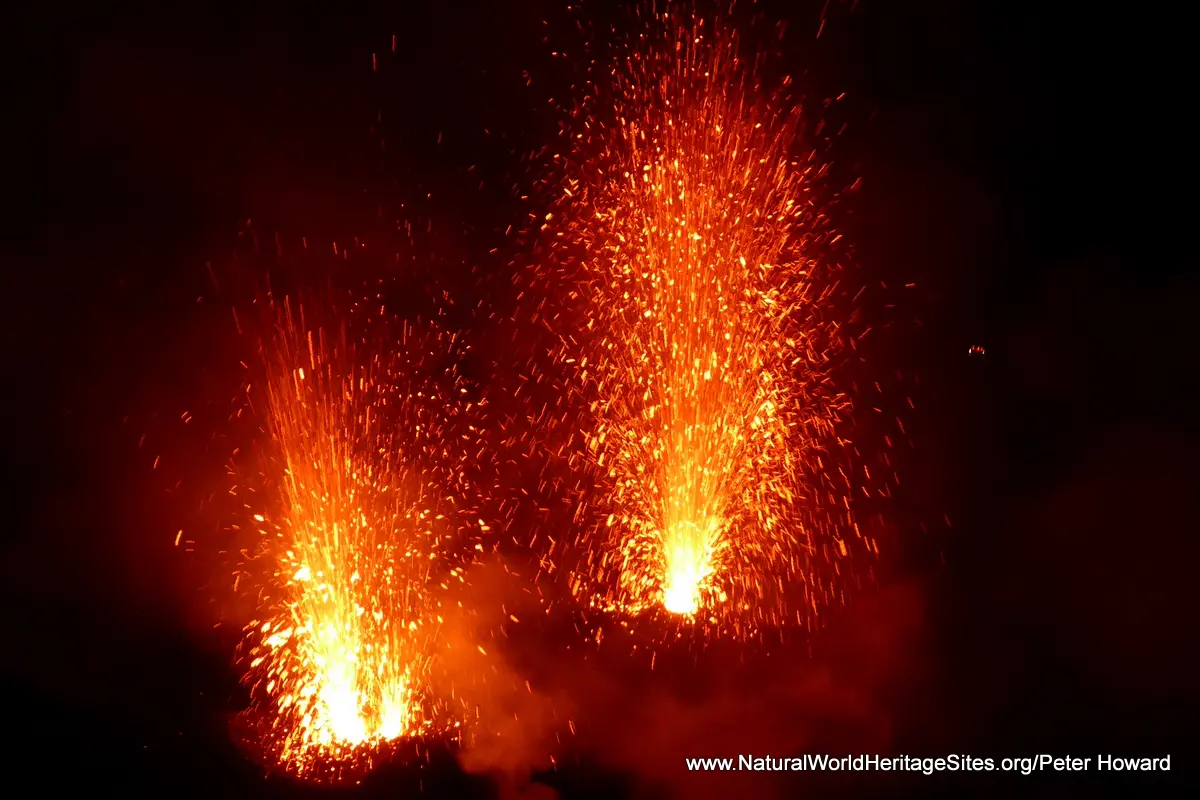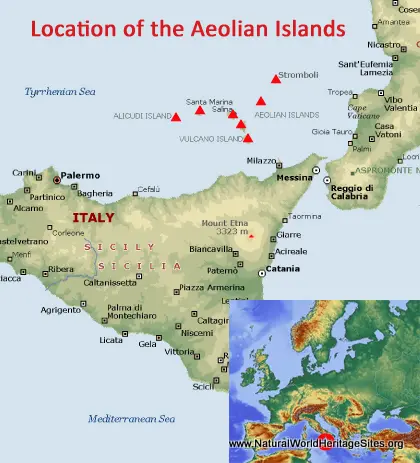EXPLORE THE ISOLE EOLIE (AEOLIAN ISLANDS) with this slideshow, check the location map and get all the facts and information below.
For slideshow description see right or scroll down (mobile). Click to view slideshow
Location and Values: The Isole Eolie (Aeolian Islands) is a group of volcanic islands lying off the north-east coast of Sicily in the Mediterranean Sea. There are seven main islands and six islets in the group, covering a total land area of 12 km2. They form part of a 200 km volcanic arc (like the Pacific ‘Ring of Fire’), resulting from collision of the African continental plate with the European one. While most of the volcanic arc is dormant and lies under the sea, three or four of the islands (Stromboli, Vulcano, Lipari and perhaps Panarea) are still active. The Isole Eolie (Aeolian Islands) group is globally important as an outstanding example of volcanic island building and destruction, exhibiting an exceptional diversity of associated geological features. In particular, the islands exhibit two of the six classic types of volcanic activity recognized worldwide by vulcanologists, which take their names from islands in the group. Strombolian volcanism involves continuous regular spurts of lapilli, bombs and blazing gas, while the Vulcanian type involves more violent eruptions at much longer intervals.
Conservation Status and Threats. According to IUCN’s most recent Conservation Outlook Assessment (December 2020) the conservation status of the Isole Eolie (Aeolian Islands) is ‘good with some concerns’. The exceptional geological values which are recognized by the site’s inscription on the World Heritage List are not threatened, but a number of issues affecting conservation of the site’s biodiversity values are noteworthy, including:
- Inappropriate land-use practices. The natural resources of the main islands are subject to heavy use by local communities and there are problems arising from over-grazing by goats and other domestic livestock, poor forestry practices, land-use changes and habitat degradation, fire and erosion. These factors threaten the survival of rare species of plants and animals that are endemic to the Isole Eolie (Aeolian Islands).
- Invasive alien species. Introduced alien species of plants and animals are displacing some of the naturally-occurring ones, including rare and threatened endemic species.
- Degradation of the marine environment. The marine environment is threatened by unsustainable fishing, pollution, maritime traffic and port infrastructure developments.
- Tourism pressures. The Isole Eolie (Aeolian Islands) receive vast numbers of visitors, resulting in inappropriate infrastructure development, pollution and pressure on fresh water resources, as well as a certain amount of erosion and degradation of vegetation in some heavily-used areas.
- Management shortcomings. The IUCN report highlights significant management shortcomings in implementing the measures envisioned when the area was designated as a National Park (following its World Heritage listing). A good management plan has been developed, but has not been implemented because it relies on a management structure that is not yet in place.
Links:
Google Earth
UNESCO Official Website
IUCN Conservation Outlook
UNEP-WCMC Site Description
Birdlife IBA
Slideshow description
The slideshow features the two islands that are most important to the world of vulcanology, and have given their names to particular types of volcanic activity: Stromboli and Vulcano. The slideshow starts in Stromboli, with views of the island from a boat tour around it, showing its classic cone shape and various geological features. These include the massive slide of grey-black ash and lava flows on the western side of the island (known as the Sciara del Fuoco) resulting from the continuous volcanic activity higher up the slope; and the characteristic old volcanic plug of Strombolicchio lying offshore, like an ancient castle emerging sheer-sided from the sea. One of the most popular activities for visitors to the Isole Eolie (Aeolian Islands) is the strenuous climb up the slopes of Stromboli at dusk, with an hour spent watching the exhilarating display of fireworks from the crater rim after dark, as the molten magma bubbles up and explodes in a 200m-high display.
The next part of the slideshow features the contrasting geology of Vulcano, starting with a boat tour around the island, and showing bathers at the therapeutic ‘mud pool’ in the Baia di Levante hydrothermal system. It then takes a tour of the island’s main La Fossa volcanic cone, providing spectacular views across to neighbouring islands and into the crater. The rim and inner slopes of the crater are pockmarked with numerous fumeroles which produce spectacular coloured deposits of sulphur, chlorides and bromides. The upper slopes are strewn with debris from the last major eruption (1888-90), including some massive bombs. The crater rim is a popular place to watch the sun set, as steam from the fumeroles is blown off the mountain top and the sun touches the sea and dips below the western horizon.
Factfile
Website Category: Earth Features
Area: 12 km2
Inscribed: 2000
Criteria:
- Geological features (viii);
Share this page
You may also like to explore these other featured sites:-
Click here to add your own text





